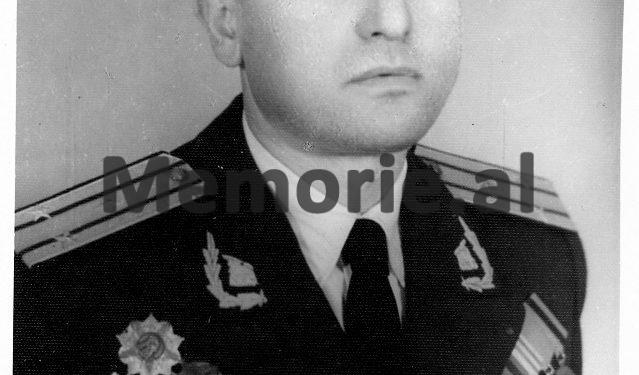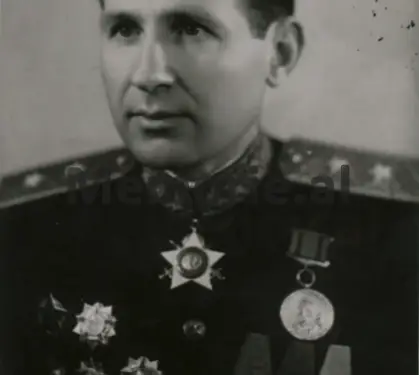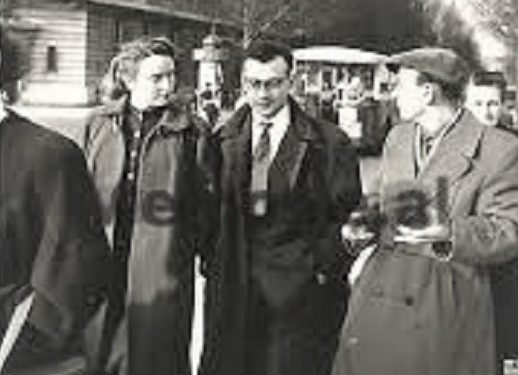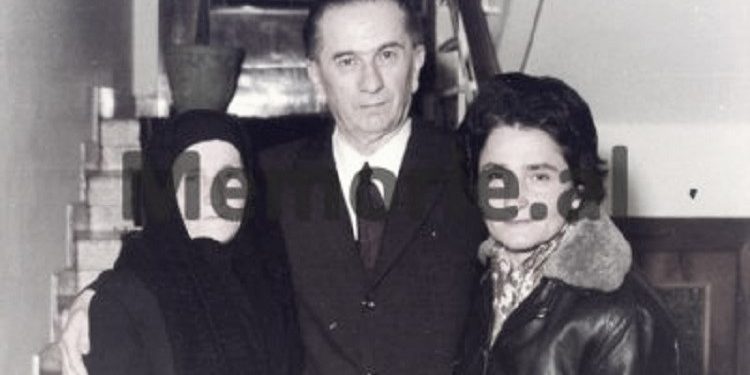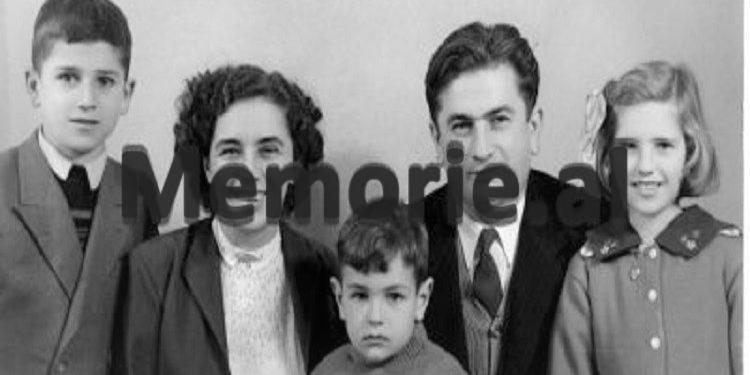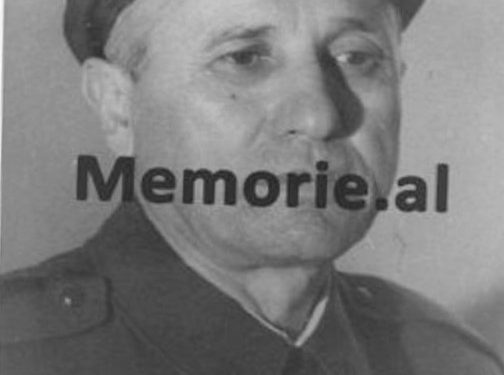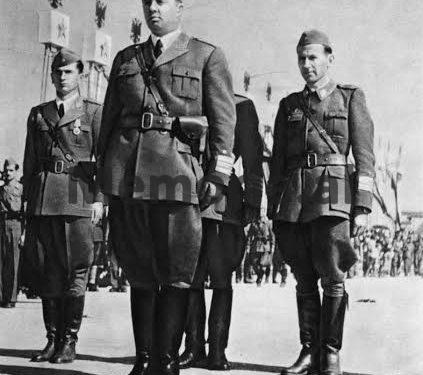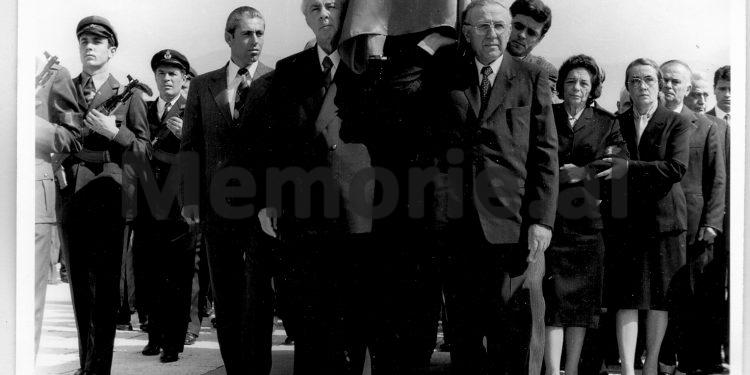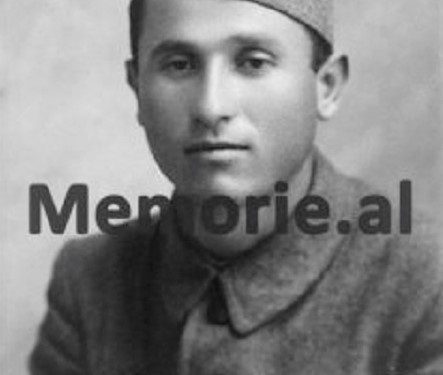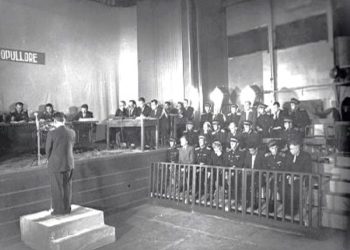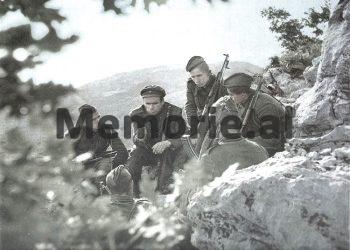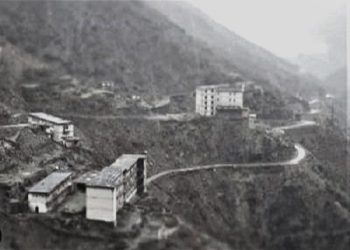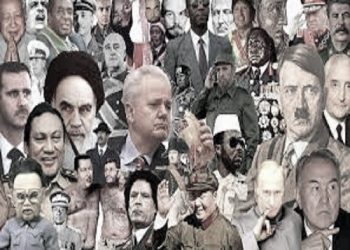Dashnor Kaloçi
Memorie.al/ publishes the unknown testimonies of Colonel Idriz Seit Sadikaj, former senior military officer of the State Security in the Ministry of Internal Affairs and Mehmet Shehu’s closest collaborator since childhood when they were close friends in the village of Çorush of Mallakastra, who in 1982 was sentenced to 10 years in political prison, as well as the testimonies of former senior State Security officers TN and M.Gj. who have served for many years with the former secretary of the Central Committee of the ALP and member of the Politburo, Hysni Kapo, who covered the organs of the ‘Dictatorship of the Proletariat’, such as: the Ministry of Internal Affairs, the State Security, the Ministry of Defense People’s Courts, Courts, Investigations, Prosecution, etc. Their rare testimonies on the mysteries of Hysni Kapos’s death in Paris, Vito’s accusation against the Minister of Internal Affairs, Kadri Hazbiu, as well as the possible scenario of Enver Hoxha for the elimination of Kapos and Shehu since 1973, when Hoxha passed a severe heart attack and his life was questioned, and for that, he initially blamed his doctors who had suggested and approached Hysni Kapo!
“In September 1979, after learning of the death of Hysni Kapos in one of the medical clinics in Paris, where he had been hospitalized for a few days and was being treated for a serious illness, his wife Vito Kapo immediately met the minister of Internal Affairs, Kadri Hazbiu and in the midst of tears and sobs, addressed him shouting: ‘Why did you poison Hysni ?!’ After this very strong and very shocking accusation that she made against him, Minister Hazbiu completely restrained and he calmly replied: ‘What do you have to say to me, why do not you tell him ?!’?! By the word ‘him’, Hazbi was referring to Enver Hoxha. The subtext of the response of Kadri Hazbiu, a very refined and intelligent man, who had headed the organs of the Ministry of Internal Affairs and State Security since 1949, was more than clear to Hysni Kapos wife, who until then was the ‘two’ of communist Albania and was considered one of the main and most likely people to replace Enver Hoxha after his death.
That very short answer that Kadri Hazbiu gave to Vito Kapos against her accusation, spoke a lot! Hazbi did not claim that her husband, Hysni Kapo, had been poisoned, but she did not deny it either! But he, excusing himself that he had no finger or that he was not implicated in what Vitua was accusing him of, inadvertently letting her know that: he had no objections to her accusation, but the address was wrong and that accusation should have been directed not at him, but at Enver Hoxha. ”
This is what the retired colonel and former political prisoner, Idriz Seit Sadikaj, said, in his testimonies with the sensational story about the mystery of the death of Hysni Kapos, the most powerful man of the Albanian communist state who held the post of Secretary for years. of the Central Committee of the ALP and the most trusted man of Enver Hoxha (as secretary of the Central Committee, he had the functional task of controlling the organs of the Dictatorship of the Proletariat, the Ministry of Interior, Defense, Prosecution, Investigation, etc.), which for the first time is made public by Memorie.al.
Also, in his testimony, Idriz Seit Sadikaj, recounts his conversations with one of the former senior officers of the State Security (TN), who for many years, has accompanied for medical visits to Paris, the most senior senior leadership of the Politburo and the Albanian communist state.
But what is the truth about the death of Hysni Kapos and is there any other evidence that sheds light on it? Why Kapos’s closest man (M.GJ.) who had stood by him for 35 years, after the death of the chief, with tears in his eyes, told his most trusted people, who at that time were in positions of high in the Ministry of Interior: “They disappeared Hysni ?!
How did the response to Hysni Kapos’ medical tests performed at the Central Laboratory of the University Clinic of Tirana come about, what did the Security officers say to the laboratory doctor who performed those tests and why did she keep it secret for 20 years?
Why did Ramiz Alia, the man who was sent by Enver Hoxha to stay with Hysni in Paris, shortly before his death, remove from the room the Albanian escorts and doctors who served him?
Why did Enver Hoxha care about the elimination of Hysni Kapos and what did Enver say on the anniversary of Ramiz Alia’s birthday, in 1969, and why did Hysni Kapo and Mehmet Shehu “blacken” after those words that meant a certain testament he was leaving for the successor of his?!
Why at the end of 1973, under the auspices of Nexhmije Hoxha, one of the instructors of the Central Committee of the ALP published two articles in “Zeri i Popullit”, regarding the faction of Sadik Premte, treating and describing as’ hostile activity the failure of the defeat of that faction ‘, for which at that time Enver Hoxha had directly charged Hysni in Vlora and Mehmet in Mallakastër?
What tasks did Enver assign to Hysni and Mehmet at that time and who were the people they had to execute without trial in Vlora and Mallakastër? Why was Enver Hoxha’s order for the execution of the leaders of the Vlora District, which had been given since the spring of 1942, dragged on for a year by them, so much so that they forced Enver to go to Vlora himself?
Why did the villagers of Gjormi arrest Hysni Kapo when he went to carry out the kidnapping and execution of “Xhepi” (Sadik Friday) and Pali Terova? Why in 1943, Enver Hoxha told “Sazan”: “You did very well to kill” Dyshekun “and” Milon “because that would have been done by any obedient communist of the party”, and in the early 1970s- In the two articles published in “Zeri i Popullit” under the auspices of Nexhmije Hoxha, they were declared “Martyrs of the Fatherland”, and in their motivation, it was said that they were “killed by the enemies of the people and the party”? !
Why did Mehmet Shehu “burn” those two articles, thinking that Enver was preparing the ground for a possible blow against him and Hysni Kapos (a scheme which had worked and in the elimination he had done in the past to his closest collaborators and to his deputies, such as: Nako Spiru, Koçi Xoxe, Bedri Spahiu, Tuk Jakova, etc.) and he handed Enver Hoxha the two letters, where his closest man, “Sazani” denounced those two articles ?!
Why did Mehmeti calm down when the Secretariat of the Central Committee, which met after the two letters of “Sazan”, declared him “Martyrs of the Fatherland”, “Mattress” and “Milon” who were killed at the Mill of Kuta and told Seit to did not bother that issue anymore?!
Why in 1982, Enver Hoxha accused Mehmet Shehu as if he had deliberately sabotaged the defeat of Sadik Friday’s faction, cunningly plotting the “incident” of the Kuta Mill, for which he himself in 1943, at Mehmet’s house in Çorush, had thanked “Sazani”?!
On these and other mysteries of the main trio of the leadership of the Albanian communist regime: Enver Hoxha, Hysni Kapo and Mehmet Shehu, we will be known through the testimonies given to us some time ago by Idriz Seit Sadika (with the nickname of the war “Sazani”) former colonel in the Ministry of Interior and one of Mehmet Shehu closest collaborators since the time of the War, as well as the testimonies of some former senior State Security officers like M.GJ. etc., who have served for many years near Hysni Kapos.
How did Enver Hoxha act to hit Hysni Kapo and what was the event he was caught for which at the end of 1973 when his life was put in great question due to the serious illness he went through, he began to prepare the terrain and the scenario of elimination of his two closest collaborators implicating them in hostile activities ?!
Who was Idriz Seit Sadikaj?
Idriz Seiti was born in April 1918 in the village of Çorush in Mallakastra, whence the origin of his family, which had emigrated to Turkey for three generations. He attended primary school in his village and while grazing cattle in the surrounding hills, he read the books of Naim Frashëri, which he took to the rich library of the large family of Shehu i Çorushi, because with his son, Mehmet, best friends. In 1932, after a quarrel in his village, Çorush, which ended in murder, Idrizi as the youngest, pleaded guilty and the court sentenced him to 21 years in prison, of which he suffered seven years in Berat prison. , from where it came out only in April 1939 when the prison doors were opened, after the Italian fascist aggression against King Zog’s Albania.
During the seven years of serving his sentence, Idrizi stayed with Kadri bej Cakran and Enver bej Risilia, who kept him close and constantly gave him books, from the personal library they had in prison. Regarding this period of time, that Idrizi stood next to two rich beys, he says that: ‘it has been a very big school for me’.
In the spring of 1939, Idrizi, together with two friends he had in prison, the Kosovar Mustafa Bajgora and the Bosnian Idriz Zenuni, tried to form a squad to fight against the Italians, but failed to achieve their goal. yourself. In 1939, a fellow villager took him with him and put him to work in the construction of Krraba Street and in Tirana, in the construction of apartments.
Later he worked for some time in the construction of the Aviation Field in the city of Kuçova and in the Port of Durrës, as a translator with the Italians. After a beating with Italians for not paying him, he was sentenced and sentenced to five months in prison. After his release from prison, his friend, the Minister without Portfolio, Beqir Valteri, informed him that the Italians were looking for him again, to punish him, and he was forced to go to the mountains, joining the Peza Çeta that commanded him, Bab Myslymi.
He then went to his village in Çorush of Mallakastra, where he set up a small committee platoon, with which he carried out several actions. In 1941, he was accused of having a hand in the assassination of the Bektashi World Leader, and for this, he continued to be prosecuted by the government that had declared him a wanted person.
In August 1942, after the return of his close friend, Mehmet Shehu, from France, Idrizi joined him, becoming his right-hand man, as deputy battalion commander in the First Assault Brigade, (where he had and his wife, as company deputy commissioner), who was formed in Vithkuq, Korça, in August 1943.
During the war, Idrizi performed some “special tasks” assigned to him by Mehmet Shehu and for them, he was also thanked by Enver Hoxha. After the end of the war, until 1949, Idrizi served in the Army and then passed to the bodies of the Ministry of Internal Affairs as a senior officer of the State Security, being appointed as “Chairman of the Special Group of officers of this ministry.” , who went out into the mountains, disguised as “Anti-Communist Resistance Groups”. During that time, he directed the well-known game, “Resistance Front” and personally participated in the capture and arrest of Zenel Shehu, Hamit Matjani, Sul Selime and many other well-known exponents of the anti-communist resistance.
After 1955, when the so-called “Reaction Gangs” were eliminated, Idrizi was appointed Chairman of the Internal Affairs Branch, initially in Kukës, Lezha and Peshkopi, where he rose to the rank of colonel. Until 1981, Idriz Seiti served in the Ministry of Internal Affairs, as ‘Chairman of the XII Branch’, which was one of the most delicate tasks that the ministry had (for the execution and burial of anti-party persons and groups). , tasks that were described as “Top secrets of special importance”.
In 1981, shortly after the incident with Mehmet Shehu, Idrizi Seiti was dismissed and in January 1982, he was arrested, accused of being “the closest collaborator of former Prime Minister Mehmet Shehu”. Based on the legends circulating at the time about his dangerousness, Idrizi was arrested with a tank and special forces of the Republic Guard. After appearing in court, Idris was sentenced to ten years in prison, which he suffered mainly in Burrel prison (where he occasionally wrote letters to Enver Hoxha), from where he was released only in March 1991, most recently political prisoners who left the prisons of Enver Hoxha’s communist regime.
“Hostile implication” of Mehmet and Hysni!
The origin of the ‘reason’ that Enver Hoxha was ‘caught’ for the beating of Hysni Kapos, dates back to the time of the War, or more precisely to June 1942, when at the meeting of the Albanian Communist Party held in the village of Labinot Elbasan, the two Yugoslav emissaries who had been attached to the SNP and its leader, Enver Hoxha, Miladin Popovic and Dusan Mugosha, ordered Mehmet Shehu to physically liquidate the two leaders of the Communist Youth Group, Anastas Lula and Sadik Premten, who were the main contenders for the post of Party leader (that of Secretary General of the SNP), who had been left vacant since the founding meeting of November 8, 1941, to be later elected on the basis of merit to have the main chairmen of the Provisional Central Committee, which emerged from that meeting.
This decision of the SNP Conference for the physical elimination of “Qorri” (Anastas Lula) and “Xhepi” (Sadik Premtja), based on the statute of the party, would be sent for notification to all cells of the Albanian Communist Party that to work it out, but this decision was never worked out in the party cells, which casts doubt on the fact that that decision was not of the SNP Conference, but of Enver Hoxha personally, to eliminate his opponents within the party, Lula and Friday, whom he saw as rivals to take the place of the party leader.
This decision for the physical elimination of Sadik Premte (Anastas Lula was executed in March 1943), which Enver Hoxha called factionalists, he entrusted to Mehmet Shehu and Hysni Kapos, in May 1943.
But Mehmeti and Hysni, according to the letter sent to them by Enver Hoxha, would not physically eliminate (by executing them without trial) only Sadik Premten, but at that time, they would also liquidate some of his supporters of the Communist Circle of Vlora, as Pali Terova, the delegate of the Central Committee in Vlora, as well as Neki Ymeri (with the nickname “Vangjo”) and Xhemil Çakërri, who were in the functions of the commander and commissar of the “Plaka Squad” of Vlora. But why did Mehmet Shehu and Hysni Kapo not implement Enver Hoxha’s order for the physical elimination of Sadik Premte? /Memorie.al
Continues tomorrow





